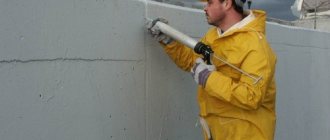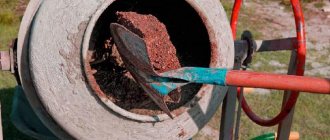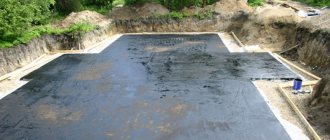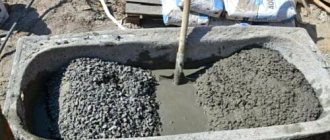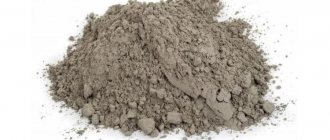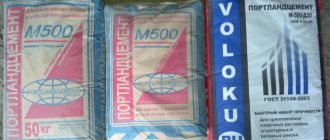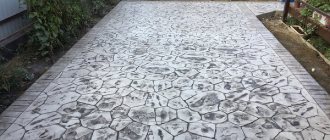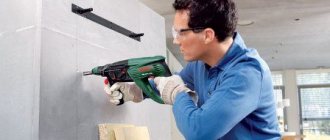Sulfuric acid salts (sulfates) contained in soil or water, upon contact with concrete, react with calcium hydroxide and aluminate components of cement stone. This causes gradual destruction of structures. The intensity of the process depends, first of all, on the amount of aluminum-containing components.
In the production of concrete mixtures resistant to this type of corrosion, special sulfate-resistant cement (GOST 22266-2013) is used as a binder.
Production and composition
The manufacturing technology of sulfate-resistant Portland cement and ordinary cement differs very slightly, but more stringent technical control is necessary.
These binders are obtained after simultaneous fine grinding of gypsum and Portland cement clinker. The mineral additives used are electrothermophosphorus and granulated blast furnace slags, the volume of which is 10-20%, and for sulfate-resistant Portland slag cement from 40 to 60%. Sedimentary rocks with a volume of 5 to 10% are used as active additives. The composition of the clinker used in production is of great importance. It should contain no more than 50% tricalcium silicate, no more than five - tricalcium aluminate. The alumina modulus must be 0.7 or more. It should be taken into account that the sum of C3A+C4AF in clinker should be no more than 22%. The composition includes magnesium oxide and aluminum oxide 5%. The requirements for raw materials are determined by the need to prepare clinker with a standardized chemical and mineralogical composition. It is recommended to use flask or tripoli as part of the clay component.
Active additives are not used, and only if an agreement is reached between the customer and the supplier and in the presence of favorable operating conditions can a small amount of them be added during grinding. All additives must comply with GOST requirements. Active mineral additives - 6269-54, and slag additives - 3476-60. To increase the resistance of sulfate-resistant types of cement, surfactants are introduced into their composition. According to the recommendations of GOST 970-61, soap naft or sulfite-alcohol stillage is used for this purpose, and after this it is called hydrophobic or plasticized.
Application in construction
It is recommended to use it for the production of monolithic concrete and reinforced concrete structures for the construction of hydraulic structures and structures that are subject to sulfate aggression and operate submerged under the influence of sea and ocean water.
It is advisable to use it in the manufacture of concrete and reinforced concrete structural elements, including prestressed ones, which will subsequently become part of the structures of pier supports, sea and river piers, as well as any types of building structures that are subject to alternate wetting and drying. Due to the reduced content of fuel-releasing components and reduced exotherm, it is permissible to use hydraulic structures with a large mass during the construction of the external zone.
Acquisition
Buying sulfate-resistant cement is not difficult: manufacturers sell it through exchanges, through wholesale trade organizations, and purchasing through exchanges, for example the Moscow Stock Exchange, allows you to significantly save on the cost of the purchased material, especially if the buyer is ready to purchase in bulk and in batches of 300 tons or more. The price in this case ranges from 3,030 to 3,730 rubles per ton. Purchasing packaged or smaller quantities will result in an increase in price.
Concrete grade for water resistance
Each brand of mixture has a water resistance class. This can be seen in the concrete waterproofing table:
Waterproofness of concrete w2 w4 w6 w8 w12
The water resistance class of concrete (w2 w4 w6 w8 w12) is selected depending on how and where the material will be used. W2 is the lowest moisture resistance rating. The use of concrete of this class requires additional waterproofing measures. Such concrete is used for preparatory work before pouring the foundation or in road construction as a concrete pad.
Composition and properties
Portland cement is made from clinker. Due to the fact that it is almost impossible to find ready-made granules in nature, clinker crumbs are created artificially from a mixture of clay and carbon mixtures. The finished clinker is mixed with gypsum (its proportion does not exceed 5%) to make the solution mobile.
High performance and technical characteristics are determined by the proportion and type of components introduced into the composition of Portland cement. This aspect is regulated by GOST 10178-85 “Portland cement and Portland slag cement”. The packaging with the powder must indicate the specifics of production and compliance with GOST.
If the container indicates TU (technical conditions) instead of GOST, this indicates that the properties of the material may differ from the regulated ones.
To give cement certain properties, various mineral additives are added to the powder (in a volume equal to a maximum of 20-25% of the total weight). Their interaction affects the chemical composition of Portland cement and largely determines its characteristics and parameters.
The most popular mineral supplements:
- Aluminate - prolongs the setting time, but exhibits low strength, and therefore is introduced into the mixture in a volume not exceeding 15%.
- Aluminum ferrite - has identical properties to aluminate, but its composition should not exceed 10-18%.
- Belit - knits, prolongs the hardening time, but in large volumes it reduces strength (add no more than 37%).
- Alite is most often added to liquid grade formulations to accelerate hardening (up to 60%).
The main properties of Portland cement are determined by its composition. When choosing a powder for preparing a solution, you must immediately decide on the scope of application and the required (desired) characteristics and optimal parameters.
Main criteria when choosing Portland cement:
- Setting speed – the standard time is 40-45 minutes. This indicator is influenced by the fineness of grinding, the composition of mineral additives, and the temperature at the facility.
- Water requirement is the volume of water required for mixing (usually no more than 25% of the total mass of the solution). To reduce the required volume of water, plasticizers and sulfite-yeast mash can be used.
- Frost resistance is determined by the number of freezing/thawing cycles that the stone can withstand without loss of quality or deformation. In order to increase the level of frost resistance, washed wood pitch or sodium abietate and special additives are often added to the mixture.
- Water separation is the squeezing out of water in a mixed solution, which appears due to the settling of heavy cement particles. To lower the indicator, mineral supplements are used.
- Heat generation - during the process of hydration (hardening). If the composition gives off heat very quickly, it may become deformed. To avoid this, use active mineral supplements.
- Corrosion resistance is determined by the degree of porosity of the frozen monolith (the fineness of the mixture).
Characteristics affecting the waterproofness of concrete
This characteristic is influenced by a complex of factors:
- Age of concrete . The larger it is (up to certain limits), the higher the resistance of the material to water penetration. This rule is fulfilled if the conditions for hardening the mixture are met. When moistened, the surface of hardening concrete quickly gains standard strength, compared to a surface exposed to air with a relative humidity of 50-70%. In conditions of rare wettability, maximum water resistance occurs six months to a year after pouring the mixture. Moisturizing the surface during hardening of the mixture is especially important for concrete with a low water-cement ratio.
- Porosity of the material . The larger it is, the less resistant the artificial stone is to the penetration of water deep into the concrete structure. Dense concrete is the most resistant to moisture penetration. Foam and aerated concrete are the most moisture-permeable, especially the latter, which are characterized by the open shape of air cells. In foam concrete, such cells have a closed structure.
- Speed of setting and hardening of the mixture . If this process occurs too quickly, it provokes the appearance of cracks and air bubbles, which reduce the moisture resistance of the material.
- Binder used . The best water resistance indicators are shown by concretes based on high-strength Portland cement and aluminous cement. During the hydration period, the components of such cements form the most dense cement stone. The higher the strength class of concrete, the higher the grade of its water resistance.
- The presence or absence of specialized additives – iron and aluminum sulfates.
To remove excess water from the mixture, making the hardened product more dense, rational mixing technologies, vacuum installations, careful vibrating with surface and deep vibrators, pressing, and vibration pressing will help.
Table of the relationship between strength classes and waterproof grades of concrete
Briefly about the main thing
- Resistance to sulfate aggression of sea, river, sewage and groundwater is carried out in two ways: • the use of sulfate-resistant Portland cement, Portland slag cement and pozzolanic cement; • the use of modifying additives that improve the quality of the concrete or mortar mixture, increasing the durability of the final product - reinforced concrete structures. Such additives can be hydrophobic, which ultimately gives concrete water-repellent properties and plasticizing, which allows, when molding products and structures, to reduce the water-cement ratio W/C and, as a result, increase the density of concrete stone.
- The most aggressive salts that have a destructive effect on concrete are magnesium and sodium sulfates. It is not for nothing that tests for sulfate resistance of cement are carried out using a 5% sodium sulfate solution.
- The main danger of sulfate corrosion is the reaction of tricalcium aluminate with sulfates from the environment and the formation of calcium hydrosulfoaluminate (HCSA), which expands in volume (by 227%) in pores and cracks and creates pressure on the concrete stone. This effect, together with the washing out of these formations by water, leads to type III corrosion of concrete.
- Sulfate-resistant cements are cements with a low content of C3A or tricalcium aluminate. Let us recall the content of the main minerals in cement clinker, the main component of cement: • Alite, tricalcium silicate – C3S. The main mineral that influences the quality of cement. Alite has the properties of a fast-hardening hydraulic substance of high strength. High-grade cements and quick-hardening cements are made with a high content of tricalcium silicate. The content in cement is 37-60%. • Belite, dicalcium silicate – C2S. Slow-hardening hydraulic binder of medium strength. Cements with a high content of belite harden slowly, but their strength increases over a long time. The content in cement is 15-37%. • Tricalcium aluminate – C3A. A melt mineral whose main task is to lower the sintering temperature of the raw material mixture. Hardens quickly, but has low strength. The content in cement is 5-15%. • Tetracalcium aluminoferrite – C4AF. Flux mineral. Hardens faster than silicates, but slower than aluminate. The content in cement is 10-18%.
Sulfate-resistant concrete - protected from all types of corrosion
Home » Concrete and brick »
The quality of most building structures directly depends on the quality and properties of the concrete used. This is especially true for those parts that come into contact with groundwater or other types of moisture containing sulfate additives.
When sulfates penetrate from the outside, concrete can collapse, as its volume increases and cracks form inside. Therefore, sulfate-resistant concrete is used for building foundations, coastal concrete structures, and structures associated with high humidity.
How do sulfates act on concrete bases?
Potassium, sodium, and magnesium salts are most often found in soil, water, and industrial wastewater. Sulfate ions are also present in aggregates.
Sulfate attack is involved in all three types of concrete corrosion:
- accelerate type I corrosion, increasing the solubility of cement stone;
- cause an exchange reaction, which leads to type II corrosion;
- participate in the formation of gypsum and calcium hydrosulfoaluminate, the accumulation of which in pores and capillaries is the cause of type III corrosion.
In concrete, calcium hydrosulfoaluminate, which is formed from gypsum and cement stone hydroaluminates, increases significantly in volume. Gypsum enters the concrete mixture in small quantities with additives or as a result of chemical reactions. The third type of corrosion proceeds slowly and begins with the appearance of a crystalline film of crystalline gypsum on the surface of a concrete structure.
Over time, gypsum crystals accumulate in the inner layers of cement stone and, at the same time, take part in the formation of calcium hydrosulfoaluminate. The latter also penetrates deep into the concrete. Gypsum and aluminates are sources of significant pressure on the walls of the pores in which they grow. This leads to the gradual destruction of concrete.
To protect concrete structures from moisture permeability and the action of aggressive water, several methods are used, but the two most common are:
- introduction of modifying, air-entraining additives, plasticizers in combination with ordinary cement;
- mix the concrete mixture with special sulfate-resistant cement.
Modifying additives
The first method significantly improves the quality of concrete without significantly increasing the price. Modifiers come in the form of solutions, powders, or emulsions that dissolve in water. Selecting the dosage is a rather labor-intensive process, since too much or too little of any element can accelerate the course of destructive chemical reactions.
The selection of the required amount of chemical modifiers in production is carried out in the laboratory, and in private construction, experimentally.
The optimal dosage amount depends on the following factors:
- type of cement;
- composition of the concrete mixture;
- production technologies for the entire structure;
- conditions in which the concrete structure will operate.
The limit amount of additives is calculated as a percentage of the mass of the concrete mixture according to the following standards:
- for plasticizers from 0.1 to 0.3%;
- for air-entraining additives from 0.01 to 0.05%;
- for superplasticizers from 0.5 to 1%;
- for additives accelerating hardening from 1 to 2%.
With the optimal selection of the type and amount of additive, I obtain sulfate-resistant cement, which can not be destroyed for a long time under the influence of sulfate waters.
Types of sulfate-resistant cements
The second method provides better protection of concrete structures from the overly aggressive and very destructive effects of sulfate environments. Concrete based on sulfate-resistant cement is much more expensive than usual, but it allows you to protect building structures at all stages of operation.
There are several types of sulfate-resistant cements:
- sulfate-resistant and pozzolanic Portland cement;
- with mineral supplements;
- Portland slag cement.
The most commonly used is sulfate-resistant Portland cement, which has proven itself in two extreme operating conditions for concrete structures:
- increases the resistance of concrete to freezing and thawing in the presence of sulfate aggression;
- reduces the cumulative effect of aggressive physical and chemical factors in areas of concrete that are in variable water levels with a high content of sulfates.
In order for concrete based on sulfate-resistant Portland cement to have all the necessary performance qualities, several methods are used:
- replace C3A with C4AF;
- increase the amount of glassy C3A, replacing crystalline C3A with it;
- mineral supplements are introduced;
- steamed to form hydrants that are resistant to sulfates.
The amount of additives and the method of producing sulfate-resistant cement depend on the specific conditions of construction and operation of the final structure.
stroitel5.ru
Composition of hydroconcrete
When selecting components for the composition of hydraulic concrete, it is important to take into account all the functions that it must perform, namely: frost resistance, water resistance and strength. Depending on the requirements, a special composition is selected
How concrete will cope with its responsibilities depends on many factors such as: the ratio of water and cement, vibration compaction, quality, time for which the mixture is kept, the quality of the added components, etc.
Video of using a hydraulic additive in concrete
Let's take a closer look at the components that make up concrete. Cement is the main component used in the manufacture of this type of concrete. There are several types of such cement:
- Sulfate-resistant cement is used when the area of the building being washed will be in contact with hard water.
- Portland and plasticized cement are the basis of mixtures that are used for the construction of buildings located in places where the water level is constantly changing and the temperature is always below zero.
- Hydrophobic cement is used to create concrete that will be used in the construction of a structure that will be constantly exposed to water.
- Slag and pozzolanic cement have chemical characteristics that can resist water damage to a structure. Hard water has its destructive properties due to the presence of minerals in it.
Important! The required density of concrete is achieved precisely due to the presence of cement in the mixture. Hydroconcrete includes, in addition to cement, many other components
One of them is quartz sands, they serve as fillers. Sand significantly increases the level of water resistance. Quartz sands are required to be used, since without them the level of water resistance drops.
The sand used for hydraulic concrete must be of high quality, and it must also contain almost no impurities. The density of sand, according to GOST, should be 2t/m3. The grain size should be no more than 2 millimeters. Neglecting this factor risks causing the level of mobility of the mixture to be undesirable. All hydraulic structures, whether dams, piers or bridges, must be very strong and reliable. To obtain these qualities, large filling components must be selected very carefully. Quite often, granite is used for these purposes because of its ability to not allow water to pass through and not to collapse under heavy loads.
Crushed stone and gravel are used in hydraulic concrete to ensure frost resistance. The structural features of gravel and crushed stone allow it to withstand sudden temperature changes.
Flakiness is a very important factor in the construction of hydraulic structures. It makes the components look flatter. The presence of crushed stone in concrete has a very positive effect on its strength due to its shape. The flat edges of the grains allow the load to be more evenly distributed throughout the entire structure, since they fit quite tightly to each other. These characteristics allow you to save cement and sand, because their consumption in this situation is significantly reduced.
Important! When hydraulic concrete is laid, it is compacted using deep vibrators. Such operations are carried out in order to increase the desired indicators
Concrete also contains various microfillers. Their presence in the mixture prevents deformation of the structure. Microfillers significantly increase the level of thermal conductivity, which has a very positive effect on the durability of the structure. The composition of hydraulic concrete includes quite a lot of different chemical components that make the mixture very high quality. Nowadays, chemists are working on the development of the CMID-4 component. This component will allow the construction of buildings that will be constantly in contact with drinking water. One of the very significant advantages of microfillers is the fact that when they are added, the cement disperses much less.
Important! When selecting a composition for hydraulic concrete, it is necessary to take into account the ratio of the proportions of the components in accordance with GOST 26633 2012
Video: Protecting concrete surfaces of hydraulic structures
Application, installation
Due to its characteristics, waterproof concrete must be laid in a short time and in large volumes.
Parameter requirements
To ensure the preservation of properties during installation, the solution must meet the requirement of reduced heat generation during drying. Its value is limited by the permissible increase in temperature, assigned in order to reduce to zero the possibility of cracks in elements of hydraulic structures with a thickness of 2.5 m or more.
To reduce heat generation, cement mixtures with a low heat of hydration or crushed ice are mixed into the solution. It reduces the temperature of the components and the solution itself. Cold water pipes are also used to cool concrete masonry. The cement content is determined by the purpose of the concrete. For internal areas, the recommended figure is 120–160 kg/m3, and for external areas – 230–275 kg/m3 and higher.
Ratio between aggregate fractions:
| Largest grain size, mm | Aggregate content | |||||
| 5-20 mm | 5-40 mm | 20-40 mm | 20-60 mm | 40-80 mm | 80-150 mm | |
| 40 | 45-60% | 40-55% | ||||
| 60 | 35-50% | |||||
| 80 | 25-35% | 25-35% | 35-50% | |||
| 80 | 50-65% | 35-50% | ||||
| 150 | 15-25% | 15-25% | 25-35% | 30-45% | ||
| 150 | 30-40% | 25-35% | 30-45% | |||
The particle size of aggregates for concrete mortar reaches 150 mm, in some cases – 200 mm or more. In addition to fine aggregate, large solid stones or pieces of them from 400 mm are used. When preparing the mixture, they are pressed down using vibrating tamping mechanisms. This saves cement consumption and reduces heat generation.
Hard solutions
In the construction of modern hydraulic structures, low-plasticity concrete solutions are widely used. They are also called hard.
They have several features when laying, namely, they are laid mechanized using special equipment - leveling bulldozers, self-propelled guns with attachments for vibratory compaction, the number of which can be up to six.
In the construction of large structures (hydraulic power stations, dams, etc.), continuous-flow laying is used.
Hydrophobic Portland cement
A distinctive characteristic of hydrophobic Portland cement is its increased water resistance. It is made by jointly grinding Portland cement clinker, gypsum and a special hydrophobic additive, which gives the cement hydrophobic properties. The composition of the hydrophobic additive includes residual synthetic fatty acids, asidol mylonaft, oleic acid, oxidized petrolatum and others. The additive is introduced into the cement in a ratio of 0.1-0.3% by weight of the total solution. During the setting of cement, they form monomolecular hydrophobic films on its surface, which reduce the hygroscopicity of cement. Thanks to this, cement can be stored for a long time in humid conditions. Concrete and mortars made using a hydrophobic additive have increased water resistance and have lower water absorption. In addition, they are more resistant to low temperatures.
Thanks to the additive, Portland cement becomes hydrophobic, while retaining all the other advantages of ordinary Portland cement, but only under the condition that the optimal additive has been introduced into the composition. If too little hydrophobic additive has been introduced into the cement, it will not be hydrophobic, but other qualities will not be affected. If too much of the additive is added to the cement, then the solution will be too porous, as it will contain too much air, causing the strength to be significantly reduced.
This type of cement is used in cases where the material has to be transported over long distances or stored for a long time before use.
Manufacturing of raw materials
When preparing concrete, a special material is used, which consists of sulfate-resistant components.
The construction industry distinguishes two methods for preparing sulfate-resistant concrete, namely:
- Regular solution. The basis of the material is ordinary cement combined with specific additives.
- Special solution. Consists of an active sulfate-resistant component. There are two forms of release - with mineral additives and in pure form.
In order for the prepared composition to meet all possible positive qualities, its production must comply with GOST standards. The optimal proportion of cement and sand is 1 part of the active component to 3 parts of auxiliary substances. The strength of the material is usually checked with a plasticizer. The moisture resistance of concrete is checked with a mixture spreading cone, the norm is 135 mm with a hydraulic cement ratio of 0.44.
To test hydrophobic cement, the solution must be exposed to water. The material should not absorb water within 5-7 minutes.
The process of preparing sulfate-resistant concrete involves replacing some components with other ingredients containing calcium sulfate. These can be various granular and mineral substances that will be used in the form of additives. If the cement is made from electrothermophosphorus slag, tricalcium aluminate is used in a proportion of 8, not 5%.
What is sulfate-resistant cement?
Sulfate-resistant cement is a material that significantly expands the possibilities of using concrete solutions in construction for aggressive conditions. The need for it is dictated by objective circumstances, when ordinary concrete is destroyed during operation. Material requirements are regulated by state and international standards.
What is the material
Sulfate-resistant cement is a corrosion-resistant material, which contains special additives (aluminates and silicates) to increase resistance to aggressive influences. It has a specific area of application when waters with a high content of sulfates are present and there is cyclic exposure to water in large quantities.
High concentrations of sulfates in a humid environment provoke sulfate corrosion. During this process, concrete components enter into a chemical reaction, which leads to the formation of cement stone inside and to the loss of salt crystals on the walls. The structure of concrete is disrupted and it collapses. Cyclic moisture also has a destructive effect on concrete - constant cycles of drying and abundant moisture, freezing and thawing. This is why cement has been developed that is resistant to sulfate corrosion.
Types of material
Pozzolanic cement. It is based on blast furnace slag and volcanic rocks (pozzolans). Among the latter components are tuff, pumice, and volcanic ash. These are active mineral additives that provide sulfate resistance. This material is not intended for conditions with cyclical humidity.
Portland cement with increased resistance to sulfates. It is made with the addition of mineral additives to the M400 brand. The material hardens slowly with a gradual increase in strength and reduced heat generation during setting. It can be used in any operating conditions.
Portland cement with a high content of sulfate-resistant minerals. The additive content is 6-10%. Material grades M400 and M500 are produced. It is distinguished by increased frost resistance and resistance to cyclic humidity.
Sulfate-resistant Portland slag cement. This is a mixture of blast furnace slag with Portland cement clinker with the addition of aluminates
An important requirement is that the slag should not consist of more than 10% aluminum oxide. Material grades M300 and M400 are produced
It has high sulfate resistance, but is afraid of frost.
In addition to being subdivided by composition, the cement in question is graded by compressive strength. This indicator is included in the labeling - from M200 to M500.
Compound
According to the production technology, sulfate-resistant cement does not differ from the production of conventional cement.
Essentially, both materials are fine powders with astringent properties. The structure is ensured by a special drying regime and thorough grinding in the bunkers of special mills. The difference is ensured by the desired composition of the mixture. The basis of mineral additives is blast furnace slag of electrothermophosphorus or granular type. Typically their content ranges from 10-22%, and for sulfate-resistant Portland slag cement - 42-55%. The active ingredients are additives from sedimentary rocks. They are introduced in an amount of 6-12%.
To ensure increased resistance to aggressive influences, special requirements are placed on the composition of the clinker used. The content of tricalcium silicate in it should not exceed 52%, tricalcium aluminate - no more than 6%, and C3A + C4AF - no more than 23%. The composition includes aluminum and magnesium oxides, but not more than 4-5%. The alumina modulus of clinker exceeds 0.7. It is recommended to introduce flask and tripoli into the clay component of Portland cement.
The basis of clinker is alite or belit. In the first case, accelerated hardening and rapid strength gain are ensured. Belite is characterized by long setting, but the final strength exceeds alite.
Active additives are used with great care. Their excessive content can worsen the technical characteristics of cement.
According to GOST, increasing resistance to sulfates is achieved by introducing surfactants. Thus, hydrophobic, plasticized materials have additives in the form of soap naptha or alcohol-sulfite stillage.
Peculiarities
Sulfate-resistant cement is produced on the basis of finely ground Portland cement clinker crumbs mixed with gypsum, a special case of ordinary Portland cement with the peculiarity of increased resistance to sulfates.
Special requirements are placed on the quality of clinker used in the production of sulfate-resistant cement. So, its chemical composition is strictly standardized:
- concentration of tricalcium silicate no more than 50%;
- aluminate concentration – no more than 5%;
- alumina module – must be more than 0.7%;
- the combined content of C3A+C4AF is less than 22%.
Such restrictions are introduced to protect the resulting structure from sulfate corrosion.
Types of material
The construction industry uses various types of cement materials, differing in the following parameters:
- composition;
- concentration of ingredients;
- the presence of special additives;
- purpose;
- properties.
In addition to the brand, the packaging also indicates the percentage composition of additives
The following types of Portland cement are distinguished:
- fast-hardening. Contains mineral additives that reduce the duration of strength development. Used for accelerated implementation of construction activities and production of reinforced concrete structures;
- sulfate-resistant. The main advantage is resistance to the effects of sulfates, which is achieved by reducing calcium aluminates in the clinker. Used for structures operating in damp or aggressive environments;
- hydrophobic. Contains surfactants that significantly reduce hygroscopicity. The result of introducing additives is increased mobility and ease of installation of the solution. The material retains its properties at high humidity;
- white. It is easy to distinguish from other cement compositions. It has a light gray color and does not contain titanium oxides, iron and manganese salts. Used for finishing activities;
- color. Contains special pigments of organic and inorganic origin, added to the clinker material before grinding. Colored compounds, for example, yellow cement, are used for finishing activities;
- pozzolanic. Resistant to sulfates, hardens quickly at elevated temperatures. Autoclave processing significantly increases the strength characteristics. Designed for use in soil as well as in damp environments;
- grouting. It is produced exclusively for sealing wells in gas and oil developments. Provides reliable isolation from groundwater and is resistant to pressure and temperature. It gains strength at the initial stage of hardening.
Cement is a dry mixture that is used specifically for preparing concrete mortar.
The following cement compositions are produced based on lime, slag and clay:
Usage
The use of sulfate-resistant cements is justified for the construction of structures exposed to aggressive environmental influences.
Namely:
- severe frosts and temperature changes;
- frequent precipitation and changes in humidity, flooding, ebb and flow, floods, groundwater;
- soil movement, subsidence or, conversely, swelling;
- exposure to aggressive chemical liquids, for example, groundwater with an unstable composition;
- seismic activity.
Therefore, most often the scope of application of sulfate-resistant cements is:
- zinc sulphate bridge piles;
- hydraulic structures working with sea or ocean water;
- underwater and underground massifs;
- sea and river piers;
- reinforced concrete structures;
- structures with increased tension.
How to do it?
Obtaining sulfate-resistant cement is possible by two methods:
- make cement mortar with special additives from mineral substances;
- the use of a special zinc-sulfate cement-sand mixture, manufactured industrially, which is durable and guarantees protection of the structure during the entire period of operation.
In the event that mineral additives are several times higher than the standard norm, the strength of the solution is significantly reduced, and the fragility of the buildings accordingly increases, which is why they are destroyed. The solution of sulfate-resistant cement must comply with the basic norms of state standards.
After all, the durability of Portland cement is several times higher than that of conventional materials. It should be noted that its main distinctive properties fully justify the high cost.
Sulfate-resistant cement reliably protects buildings and structures from the effects of moisture and frost, and increases the wear resistance of structures. It can also significantly improve the quality of a simple concrete mortar, resulting in such a building material lasting longer than its usual stated life.
To learn how to properly mix cement mortar, watch the video below.
Waterproof concrete
The water resistance of concrete is one of the main qualities of a building material. It has no voids in its structure and is dense. The seams between the sections are filled with a waterproofing substance. Concrete has specific characteristics, has a number of advantages and is widely used. Waterproof concrete is used only in monolithic structures (for foundations), because prefabricated buildings have many seams, which makes it impossible to achieve moisture impermeability.
Waterproof concrete is designated by the letter W, even numbers from two to twenty. They mean the level of pressure (measured in MPa x 10 -1 degrees), at which waterproof concrete can withstand water pressure and prevent the passage of moisture.
Specifications
Ordinary or reinforced concrete mortar has very weak resistance to the following natural factors:
- low and high temperatures (frost and heat);
- sea, river and groundwater flow;
- acid, sulfate and salt effects.
Sulfate-resistant concrete has the following positive characteristics:
- Even at high hydrostatic pressure it remains intact and stable, the structure does not collapse and retains its original appearance.
- Service life is significantly increased.
- Thanks to the composition, the corrosion process from constant contact with water is eliminated.
- Does not interact with sulfate-containing substances.
Use in construction
Sulfate-resistant dry mixture has a high cost, so it is usually used where it is difficult to do without it. Such structures include concrete and reinforced concrete elements for hydraulic engineering purposes, structures operating under water, especially in high salinity (sea or ocean water).
This material is mainly used in structures exposed to periodic exposure to water. Among them, river and sea breakwaters, bridge elements, embankment strengthening, dams and dams stand out. Taking into account the low heat generation during hardening, such cement is used for external coatings of large thickness and mass.
Sulfate resistant cement
Let us remind you what cement is - it is an artificial material that is obtained from magnesium and carbonate-silicate rocks by sintering in huge kilns (up to 180 m). The clinker obtained after firing is poured into ball mills with the addition of up to 6% gypsum (CaSO4x2H2O). Next, the resulting powder is pumped into silos by pneumatic transport. This produces ordinary Portland cement, named after the English island of Portland, where it was first produced in 1824.
In order to give Portland cement sulfate-resistant properties, it is given a certain mineralogical composition at the production stage. Two letters C are added to the labeling, which means sulfate-resistant. The table for regulating the content of minerals in clinker is taken from GOST 22266 - 2013.
From this table it is clear that it is important to maintain normal levels of tricalcium aluminate, which is a harmful component when interacting with sulfates. We talked about this at the beginning of the article.
The formation of calcium hydrosulfoaluminate (HCSA) leads to damage to the concrete stone due to expansion during the reaction, and subsequently to the leaching of this formation from the concrete body. This is how type III concrete corrosion occurs.
Strength grades of sulfate-resistant cement are B32.5, B42.5, B52.5.
Designation
Sulfate-resistant cements are easy to distinguish - just interpret the markings correctly. It contains basic information about the material.
Using the example of TsEM I 42.5B SS GOST 22266-2013:
- CEM I – Portland cement without additional mineral additives;
- 42.5B – cement strength class after 28 days according to GOST 31108, corresponds to M500 (GOST 10178-85);
- СС – designation of sulfate resistance of Portland cement;
- GOST 22266-2013 is the state standard to which this material corresponds.
In the same way, you can read the markings of other types.
In addition, cement with plasticizers (PL) and water repellents (GF) must be labeled accordingly, for example: TsEM I 42.5N SS PL GOST 22266-2013 (sulfate-resistant cement of strength class 42.5N with plasticizer).
Low-alkaline cement with an R2O content of no more than 0.6% is designated as NShch (TsEM I 32.5B SS NShch PL GOST 22266-2013).
Kinds
Portland cement can be pure or with additives. Binder without additives does not contain minerals, only gypsum. This material is used in the installation of underground/ground and underwater monolithic objects, prefabricated concrete/reinforced concrete structures operated in the absence of a clearly defined aggressive environment.
Mineral additives can significantly improve certain properties of a material that can be used in water and aggressive conditions. The most popular additives: active minerals, blast furnace slag. They improve resistance to corrosion, water, frost, chemicals, etc.
Types of Portland cement by additives (what the binder is made from):
- Normally hardening - no additives.
- Quick-drying - hardens within 3 days after pouring due to the inclusion of mineral additives and slag in the composition. The grinding of the mixture should be minimal; there are grades M400 and M500. Thanks to the use of the substance, it is possible to speed up the completion of work, which is important for prefabricated and reinforced concrete objects.
- Plasticized - the composition contains special additives to reduce water absorption, increase mobility and heat resistance. Plasticizers are introduced into the powder at the grinding stage; they envelop the cement particles, preventing them from sticking together. The composition is comfortable to work with and is suitable for working with complex architectural structures.
- Hydrophobic - does not absorb moisture, sets quickly due to the presence of asidol and soap naphtha in the composition. Used in conditions of high humidity, on objects with a risk of flooding.
- Portland cement cement – protects wells from groundwater, is relevant in the gas/oil fields, as it is not afraid of temperature and pressure, it holds the structure even at the beginning of hardening. There is a lightweight cement composition containing appropriate additives.
- Expanding – increases in volume when kneading. Used for filling cracks and seams, in various types of repair work.
- Portland cement with slag - with the addition of blast furnace slag, which increases the volume of metal particles in the composition and makes the hardened stone resistant to fire. This is how they are obtained, which is used to create objects under water, on the ground, and at considerable heights. But the frost resistance of the composition is low.
- Sulfate-resistant – not afraid of sulfate waters that provoke corrosion. Most often, this type of cement is also frost-resistant and is produced in grades M300-M500.
- – used for decorative purposes during architectural and finishing works, often painted with different pigments. The manufacturer obtains white cement by using white clays, pure limestones, and cooling the clinker with water.
- Slag-alkali cement demonstrates even higher performance and properties in comparison with conventional Portland cement. Resistant to aggressive influences, environments, temperature changes, heat and frost, moisture. Such characteristics can be obtained by introducing alkali and ground slag into the composition, and less often - clay.
- Colored - relevant for decorative works, obtained by adding pigments (ochre, red lead, chromium oxide, etc.) to white Portland cement.
- Magnesium - produced by heating magnesium oxides to a high temperature and adding an aqueous solution of magnesium chloride 30%. The creation technology and components make the cement durable and easy to finish (polishing, resisting microorganisms, etc.). Often used for finishing and complex structures.
- – created from colored cement, gypsum, additives of sedimentary or volcanic origin. The solution is resistant to water, hardens even under water, therefore it is used in the construction of hydraulic structures, for lining various types of tanks, and surfaces in contact with chlorinated or sea water. The hardened stone is durable, resistant to water and chemicals, and does not cause efflorescence.
- Aluminous - durable, quickly hardening cement based on clinker and limestone in molten form. The powder contains a lot of calcium aluminates (low basic). It hardens at +25C and below, otherwise it loses half its strength. It is prohibited to mix the material with other types of cement and additives. Typically, the powder is used to create acid-resistant solutions, filling granite, beshtaunite and other acid-resistant rocks. This mixture sets within 8 days.
Colored and white Portland cement
Along with protection from aggressive factors, cement must have good aesthetic qualities.
There are 2 types of mixtures:
- White Portland cement.
It is produced using the same technology as simple cement. The difference is the white clinker content. An important indicator is the type of clay used. It should contain a small amount of metal oxides that impart yellowness. Whiteness is achieved by converting iron carbide into oxide.
- Color.
It is made on the basis of white cement by adding dyes. The latter are hematite ore, phthalocyanine pigments, iron oxide, and soot.
History of cement
The word “cement” comes from the Latin caementum, which translates as “crushed, broken stone.” This substance was the result of a search for ways to cope with the low water resistance of gypsum and limestone rocks. For this purpose, water-resistant mineral substances were introduced into their composition. At the very beginning, they were the remains of baked clay bricks and volcanic rocks. The ancient Romans used ash deposits from the famous volcano Vesuvius - pozzolans.
The optimal cement production technology was developed many years later, when the need for large quantities of inexpensive and durable binder did not become most acute. The greatest contribution to the research was made by:
- Mason John Aspind, who received a patent for Portland cement in 1824.
- Russian builder Egor Cheliev, who wrote a book about cement for underwater work in 1825.
The name Portland cement comes from the English island of Portland, which consists of limestone rocks. In England, stones from this island were considered the most prestigious building material. Aspind managed to obtain an artificial stone, which in strength and color was very similar to the specified material.
Recommendations
It is worth noting that sulfate-resistant cements are an important part in the construction of structures that are subjected to severe climatic conditions, such as variable humidity and temperature fluctuations.
It is necessary to take the choice of materials with due responsibility, because sulfate-resistant cements are selected individually for different conditions.
In most cases, an important selection criterion is the type of soil, its acidity and density. But when choosing, you should also pay attention to the fact that the purchased products comply with state quality standards (GOST).
Interesting and useful information about building materials and technologies
Impregnation of piles with bituminous materials using surfactants
The widespread use of pile foundations instead of monolithic or prefabricated foundations provides significant savings in time and materials.
But in a number of areas, the use of such foundations is difficult due to the salinity of soils and groundwater, which significantly exceeds the maximum concentration of substances dissolved in them prescribed by standards. When examining the foundations of main pipeline supports on the territory of the city of Guryev, after 7-8 years, a large number of new formations (corrosion products) and damage were discovered in concrete that did not have protection. Chemical analysis of the water extract showed that foundations in contact with mineralized groundwater contain over 14,000 mg/kg of sulfates (in terms of SO ions). This indicates the need to isolate concrete from aggressive waters.
Protection of reinforced concrete driven piles from corrosion can be done by increasing the density of concrete, using sulfate-resistant cements, painting with a solution of bitumen in gasoline, applying protective coatings of epoxy resins, impregnation with bitumen or petrolatum. However, piles made of high-density concrete with sulfate-resistant cement or painted with bitumen solutions could only be used in soils with a lower degree of water salinity [3]. Protective coatings made from epoxy resins are not used due to their scarcity and high cost.
Impregnation of concrete with protective materials compares favorably with other methods of protection in terms of durability and reliability. The impregnating material, penetrating into the concrete to a certain depth, does not lose its continuity during transportation and driving piles.
Currently, impregnation of piles is carried out:
in open baths at atmospheric pressure, where the penetration of a solution or melt of the impregnating material occurs mainly due to capillary suction;
in open baths with the simultaneous use of internal vacuum, for which the air inside the product is pumped out;
the method of condensation vacuum, which occurs when the temperature of the product decreases as a result of cooling the impregnating material or when using the method of cold and hot baths;
in autoclaves from which air is pumped out to remove it from the pores of concrete; then /impregnating material is introduced and excess pressure is created.
It should be noted that the first three methods are not very productive, and the fourth requires complex equipment. The main disadvantage of impregnation is the slow penetration of the impregnating material into concrete. For example, impregnation of reinforced concrete piles and parts of pipeline supports in molten bitumen to a depth of 20 mm at a temperature of 180-230 ° C lasts from 20 to 26 hours, depending on the density of the concrete. In addition, using existing technology it is impossible to perform it without preliminary drying and heating for 15-20 hours. All this requires large heat consumption and significant production space.
As a result of the search for the most economical solution, a method of concrete impregnation using surfactants was developed. Its essence is as follows. The pore walls of concrete have hydrophilic properties, i.e. they are well wetted by water and aqueous solutions [5]. When concrete is impregnated, a liquid with hydrophobic properties penetrates into capillaries with hydrophilic pore walls. Bitumen - resinous natural (petroleum asphalt) and artificial substances - have these properties. obtained during oil refining (6J. Bitumen are colloidal systems in which the role of a dispersed medium is played by resins and oils, and the dispersed part is asphalt, therefore they are most often used as protective materials.
Production of reinforced concrete products for foundations
The scope of application of piles is exclusively the creation of supports for buildings and structures for a wide variety of purposes. With their help, pile foundations and frames are constructed, which are the only possible option on sandy and clayey soils, weak and mobile soil. In regions with seismically active soil, piles are an indispensable foundation element.
These reinforced concrete products are not used for all structures, but only for multi-story construction. Their use significantly speeds up the progress of construction, making the building stronger, more reliable and durable. A pile foundation or frame not only strengthens the structure, but also prevents cracks from occurring due to ground movement.
When producing reinforced concrete piles, great attention is paid to their strength and durability. They are driven into the ground using a pile driver - a hammer that drives long piles into the ground.
